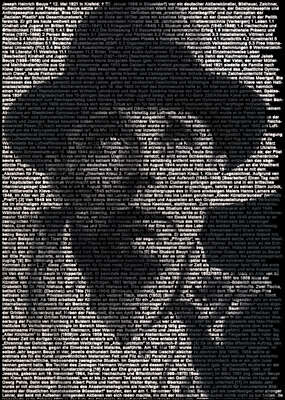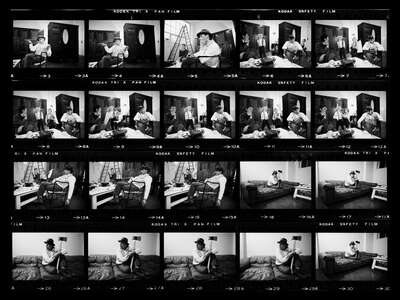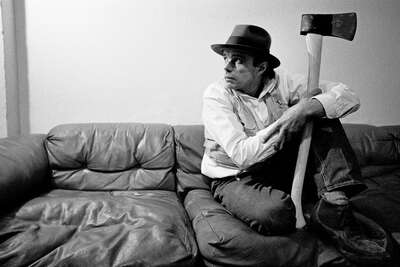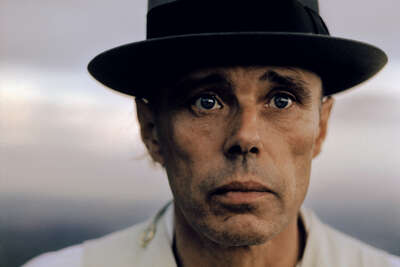
is an artist
Joseph Beuys- the art
2022 marks the 101st birthday of Joseph Beuys. Look back on the life and work of one of the greatest artists of the century. Find striking portraits and wall art of the enigmatic artist in the LUMAS portfolio. Discover more about the life of Joseph Beuys below.




Joseph Beuys - the artist
Joseph Beuys is one of the most renowned and influential post-war German artists. Dressed in his trademark fishing vest and felt hat, the painter, sculptor, draughtsman, performance artist and art theorist was never tied to any single discipline. Rather, his diverse portfolio can be best categorized as conceptual art. Some of his most famous works include:
- Fettstuhl (1964)
- How to Explain Pictures to a Dead Hare (1965)
- Das Rudel (1969)
- I like America and America Likes Me (1974)
- Honey Pump at the Workplace (1977)
- 7000 Oak Trees (1982)
Beuys considered art, politics and society to be inseparably intertwined elements of the same democratic process, reflected in his famous statement “Everyone is an artist”. Beuys coined the term social sculpture to describe his belief in art as a means of reflecting and shaping wider society. In practice, this meant making the artistic process accessible to everyone as well as promoting mass participation in creative projects. Beuys was determined that this should apply not only to art, but also to economic and political systems. It's unsurprising then, that he was personally involved in politics – in addition to founding several initiatives promoting direct democracy, he ran in the 1979 European Parliamental elections as a candidate for the German Green Party.
Joseph Beuys was also a renowned Professor of Art at the Kunstakademie Düsseldorf. He held this post from 1961 until his dismissal in 1972 as a result of his decision to accept hundreds of students into his class who had previously had their applications rejected by the university. Some of Beuys’ notable students from this time include Jörg Immendorff, Anselm Kiefer, Blinky Palermo and Katharina Sieverding.
Joseph Beuys - the myth
Another of the 20th century’s most iconic artists, Andy Warhol, met with Beuys several times. Both men broke down walls and expanded the definition of art in their own ways: Beuys, by constantly striving for a better world through community action and incisive criticisms of capitalist systems; and Warhol, who framed consumerism as an art form in its own right. Warhol even used Beuys as a subject for one of his iconic pop art portraits. The screen-printed work, coated with diamond dust, was first exhibited in Naples in 1980.
Joseph Beuys remains a controversial figure to this day. Many consider the visionary Krefeld-born artist a true genius, while others dismiss him as a charlatan. What we do know is that many events in his self-written life story have been found to be falsehoods. Beuys was an adept storyteller, and created his own personal myth, one which incorporated many elements from his works into stories of supposedly revelatory moments from his own life. For example, we know that in 1944, Beuys was in a plane crash over Crimea while serving as a radio operator and gunner in the Luftwaffe. He was rescued and recovered in a German army field hospital. In Beuys’ version of events, he was wrapped in layers of felt and fat and nursed back to health by Crimean Tartars – a claim that is now viewed as almost certainly untrue. These and other spurious claims caused critics to doubt Beuys’ character and dismiss his ideas and artworks out of hand. Furthermore, his involvement with the Nazis during the Second World War should be acknowledged and critically assessed. As an activist, artist and social critic, however, Joseph Beuys’ influence on modern art cannot be overstated.
A brief history of the life and art of Joseph Beuys
| 12.05.1921 | Joseph Heinrich Beuys is born in Krefeld, Germany. |
| 1936 | A young Beuys joins the Hitler Youth |
| 1941-1945 | Beuys enlists the German airforce (Luftwaffe) as a radio operator and completes several missions. |
| 1946-1948 | Beuys enrols in the sculpture course at the Kunstakademie Düsseldorf. During this time, he develops an interest in the spiritual movement of Anthrosophy, becoming acquainted with spiritualist philosopher Rudolf Steiner. |
| 1947-1961 | During his studies at the Düsseldorf Kunstakademie, Beuys gains experience in diverse disciplines including drawing, sculpture and gravestone making. Outside his studies, he works on nature documentaries by Heinz Sielmann and Georg Schimanski. |
| 19.09.1959 | Marries Eva-Maria Wurmbach. Their children, Boein Wenzel and Jessyka, are born in 1961 and 1964. |
| 1961-1972 | Beuys becomes a professor at the Kunstakademie Düsseldorf. Here, he begins his event series of „Fluxus evenings“, revolutionizing the art world with his socially engaged artistic ideas. |
| 1964 - 1982 | Regularly participates in the leading contemporary art exhibition series Documenta. Worky by Beuys shown in Documenta 4 to 7 include the Queen Bee series, Raumplastik, Office for Direct Democracy by Referendum, The Pack, and 7000 Oak Trees. |
| 08.10.1972 | Beuys defeats Abraham David Christian in a boxing match as part of his Documenta 5. The artists had previously feuded over art and politics. |
| 1973 und 1986 | Occasionally, Beuys‘ works would be unknowingly destroyed. In 1973, two women removed the bandages and plasters from Beuys’ Baby Bathtub installation when looking for a basin to wash glasses in. In 1986, a corner filled with fat in the Düsseldorf Kunstakademie was removed by cleaners, not realizing the work was in fact the sculpture Fettecke. |
| 15.05. - 17.07.1984 | The joint exhibition Joseph Beuys & Nam June Paik, held with multimedia artis Nam June Paik, takes place in Tokyo. |
| 23.01.1986 | Joseph Beuys dies of pneumonia in Düsseldorf. |
| 12.06.1987 | Wenzel Beuys completes his father’s work of planting 7000 oak trees in Kassel’s Friedrichsplatz for Documenta 8. |





 No thanks, I would like to stay on this site.
No thanks, I would like to stay on this site. Yes, I would like to switch.
Yes, I would like to switch.